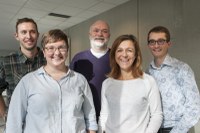UNamur and SCK•CEN send Rotifers In SpacE (RISE): a world first!
On December 4, the UNamur and the Belgian Nuclear Research Centre (SCK•CEN) will launch a unique experiment at the International Space Station (ISS). Bdelloid rotifers, microscopic animals known as extremophiles, will be sent to space in order to study their resistance to cosmic radiation and microgravity.
These organisms turn out to be extremely stress tolerant because of an efficient antioxidant and DNA repair system. To decipher the underlying mechanisms of their strong radioresistance, scientists will study how space environment is affecting gene expression of bdelloid rotifers and how space flight affects the genomic architecture. This unprecedented space research will contribute to a better knowledge of their biological response to the world’s most extreme environment.
The RISE project builds on a multidisciplinary Belgian partnership. On the one hand, the UNamur team relies on the expertise of the Laboratory of Evolutionary Genetics and Ecology (LEGE) led by Prof. Karine Van Doninck and the Laboratory of Analysis by Nuclear Reaction (LARN) led by Prof. Stéphane Lucas. The LARN lab, which is a member of NARILIS, holds a strong know-how in the field of radiobiology and possesses irradiation facilities enabling to study the impact of ionizing radiation delivered by particle accelerator on the human health. On the other hand, the RISE project also involves the Laboratory for Radiobiology of the SCK•CEN led by Prof. Sarah Baatout. This lab is devoted to provide scientific knowledge to the authorities and to inform the population about health risks resulting from environmental, occupational, accidental, medical, or cosmic exposure to radiation.
Besides better protecting astronauts from space radiation and allowing to further space exploration, this research will also prove its worth on earth. The research findings will help to find ways to improve protection of professionally exposed people or cancer patients during radiotherapy against the negative effects of radiation.
Follow the adventure on the ROTIFER IN SPACE website
From left to right: Ing. Richard Coos (electromechanics engineer at LARN ), Lucie Bruneau (laboratory technician at LEGE), Prof. Stéphane Lucas (head of LARN), Prof. Karine Van Doninck (head of LEGE) and Dr. Boris Hespeels (postdoc at LEGE, scientific manager of the RISE project at UNamur).
 NAmur Research Institute for LIfe Sciences
NAmur Research Institute for LIfe Sciences


